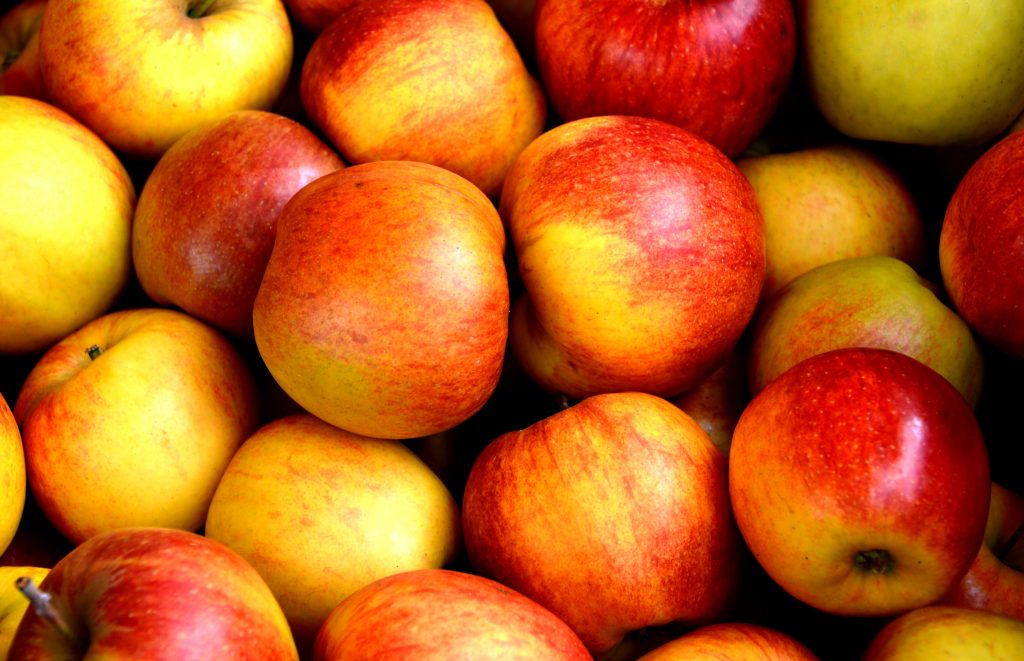
With autumn fully established, apples are falling out of trees up and down the country. I don’t suppose the apples left to rot in back gardens are included in food waste statistics, but it is still a shame not to make use of this fantastic food source that for many people is just there for the taking.
Reeth has been celebrating Apple Day for a while now in the Community Orchard – this year it was on October 26th. It provides a chance to share tips and get advice from experts, buy apple juice, or get your own apples juiced for free. Gray Walker from ScenicView captured the whole juicing process on camera with this excellent set of photos.
Apple Day events are organised in towns and villages all over Britain. They are the essence of a community approach to sustainability, bringing people together (many of whom have no other involvement in food production) to create a valuable and delicious product that would otherwise go to waste, and sharing equipment (presses and ‘scratters’) that isn’t in general ownership.
Apple juice will keep in the fridge for a week or so, or can be successfully frozen. However, for me, the best way to preserve apple juice is to turn it into cider. I’m still drinking last years’ which, once made, just sits in the garage until it’s needed. It’s worth remembering that it can take 100 gallons of water to make a gallon of beer, and a carbon footprint of up to 7kg. In contrast, I can make a gallon of cider with nothing but apple juice, and a pint or two of cold water for cleaning.
It is amazingly easy to make cider. Fill a demijohn with apple juice, stick an airlock in the top and there’s a fair chance you’ll get drinkable cider in a few months’ time (natural yeasts present in the juice will do the fermenting). Introduce a bit of sterilisation and some cider yeast and success will be almost guaranteed if you follow two rules. First, avoid using only cooking apples (the juice tastes sweet but contains too many tannins). There are apple varieties grown specifically for cider making, but you can get good results with eaters. Second, keep oxygen away from your cider, unless you want vinegar.
Of course, this is just one amateur’s take on the process and as you might imagine, there are as many ‘correct’ ways to make cider as there are cider makers. To my mind, the definitive reference source is Andrew Lea. Did you know there used to be a National Fruit and Cider Institute, funded by government to research and develop cider making? He worked there.
You may be thinking that apples grow best in warmer climes than Swaledale, and cider is a southern brew. If so, don’t despair. There are good cropping apple trees all along the dale, even as far as the Community Orchard in Keld which was successfully planted a few years ago with some suitably hardy varieties recommended by the National Park. And Swaledale cider expert John McCoy kindly sent me a list of the apple varieties he has planted in Low Row, all of which grow well in the dale. Surely the names alone are enough to whet your appetite: Black Dabinett, Browns, Dunkertons Late, Hangy Down, Harry Master’s Jersey, James Grieve, Katy, Keswick Codling, Kingston Black, Major, Michelin, Morgan Sweet, Sops in Wine, Sunset, Sweet Alford, Sweet Copin, Tom Putt, Tremlett’s Bitter, Tydemans Late Orange, Yarlington Mill?
Can there be a better way to earn your sustainability stripes? Plant some trees. Pick your own apples or persuade a neighbour to let to collect up the ones they don’t want. Get juicing. Make some cider. Pour yourself a glass, sit back and feel virtuous!
By Rob Macdonald
Further Reading:
Common Ground, Apple Day https://www.commonground.org.uk/apple-day/
The Guardian, What’s the carbon footprint of … a pint of beer https://www.theguardian.com/environment/green-living-blog/2010/jun/04/carbon-footprint-beer
Lea, Andrew, Cider-making: an Overview http://www.cider.org.uk/cidermaking.pdf
Lea, Andrew, The Science of Cider Making http://www.cider.org.uk/part1.htm
I have a couple of Apple trees but would like to plant some more so many thanks for listing the varieties that do well in Swaledale.
Which is the best nursery to get the trees from ?
I bought some apple, pear, quince and other trees from Weasdale Nurseries https://www.weasdale.com/ in the Howgills. At least they are grown in similar conditions to Swaledale, so they aren’t ‘shocked’ when they are transplanted. I’ve also bought from R V Rogers in Pickering http://www.rvroger.co.uk
Just found this list from my ‘research’ into local apples in 2016: The Yorkshire Apple Collection, Great Yorkshire Showground, Harrogate. In November 2001, 16 Yorkshire varieties were planted by members of the Northern Fruit Group: Fillingham Pippin, Yorkshire Beauty (left), New Bess Pool, Sharleston Pippin, Ribston Pippin, Charlestown Pippin, Yorkshire Aromatic, Flower of the Town, Nancy Jackson, Hunt House, Yorkshire Cockpit, Dog’s Snout, Grandpa Buxton, Green Balsam, Yorkshire Greening, Acklam Russet. https://thenorthernfruitgroup.com/